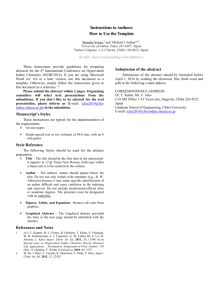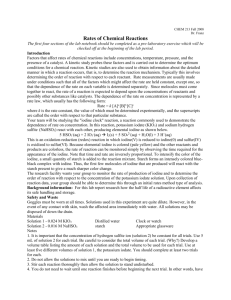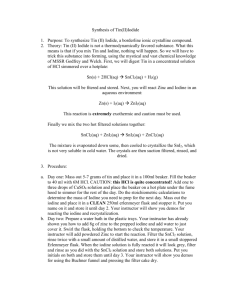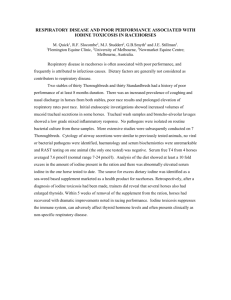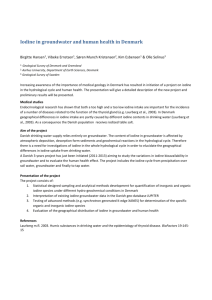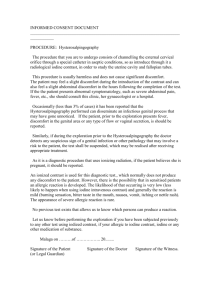Radiolytic oxidation of iodine in the containment at high temperature
advertisement
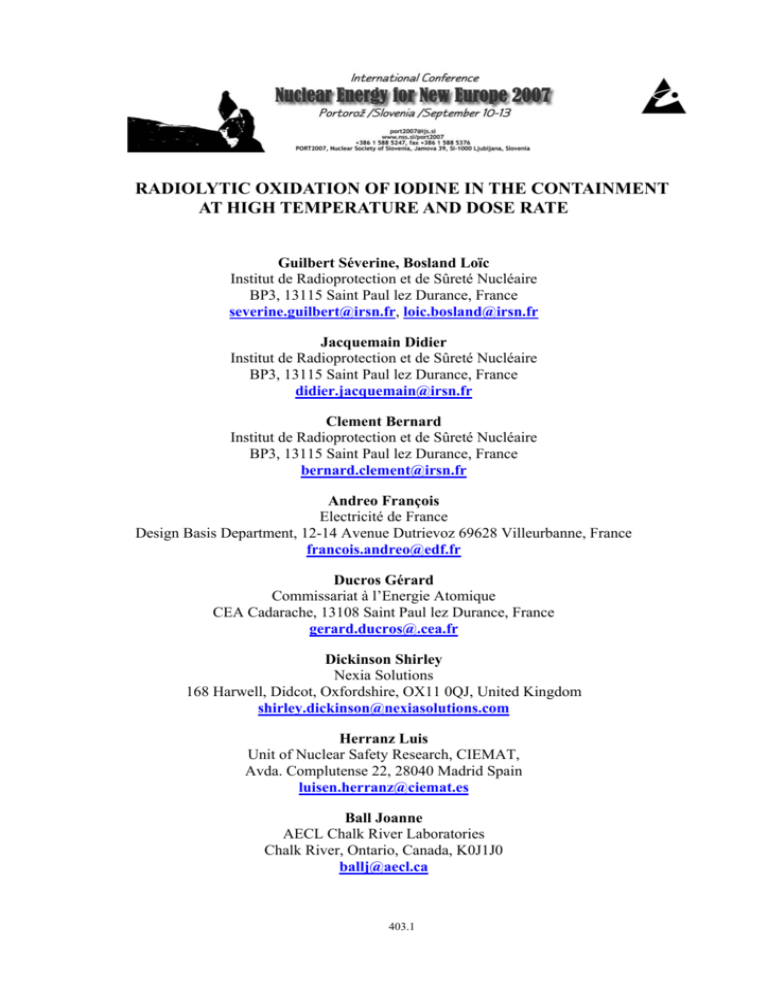
RADIOLYTIC OXIDATION OF IODINE IN THE CONTAINMENT AT HIGH TEMPERATURE AND DOSE RATE Guilbert Séverine, Bosland Loïc Institut de Radioprotection et de Sûreté Nucléaire BP3, 13115 Saint Paul lez Durance, France severine.guilbert@irsn.fr, loic.bosland@irsn.fr Jacquemain Didier Institut de Radioprotection et de Sûreté Nucléaire BP3, 13115 Saint Paul lez Durance, France didier.jacquemain@irsn.fr Clement Bernard Institut de Radioprotection et de Sûreté Nucléaire BP3, 13115 Saint Paul lez Durance, France bernard.clement@irsn.fr Andreo François Electricité de France Design Basis Department, 12-14 Avenue Dutrievoz 69628 Villeurbanne, France francois.andreo@edf.fr Ducros Gérard Commissariat à l’Energie Atomique CEA Cadarache, 13108 Saint Paul lez Durance, France gerard.ducros@.cea.fr Dickinson Shirley Nexia Solutions 168 Harwell, Didcot, Oxfordshire, OX11 0QJ, United Kingdom shirley.dickinson@nexiasolutions.com Herranz Luis Unit of Nuclear Safety Research, CIEMAT, Avda. Complutense 22, 28040 Madrid Spain luisen.herranz@ciemat.es Ball Joanne AECL Chalk River Laboratories Chalk River, Ontario, Canada, K0J1J0 ballj@aecl.ca 403.1 403.2 ABSTRACT Iodine Chemistry is one of the areas of top interest in the field of nuclear power plants (NPP) severe accidents studies. The strong radiological impact of iodine on man health and environment, mostly through its isotope I-131, has made it a key point to get an accurate prediction of the potential iodine release from the NPP containment to the environment in the low probable event of an accident leading to core melt. Released from the fuel as a gaseous form, iodine enters the containment in gaseous or particulate form and undergoes deposition processes that eventually take it to the containment surfaces and sump. Once in the sump, iodine, when present as soluble compounds, gets dissolved as non volatile iodide (I-). Nonetheless, in the presence of radiation and particularly in acidic sumps, iodine can be oxidized to volatile forms such as molecular iodine (I2) and can escape from the sump to the containment atmosphere (sump radiolysis process), thus increasing its potential contribution to the iodine source term. Iodine sump radiolysis has been extensively studied experimentally in the past decades. Experiments have revealed that parameters such as pH, temperature and total iodine concentration have a large impact on iodine volatility. However, experimental data at elevated temperatures (> 80°C) and elevated dose rates (> 1 kGy.h-1) anticipated in containment during a postulated severe accident are too scarce to provide for these relevant conditions an accurate determination of the volatile iodine fractions. Furthermore, some data were obtained from post-irradiation analysis and iodine concentration may be underestimated at the time of measurements compared with that during irradiation, due to post-irradiation reactions. To complete the existing database, the EPICUR program was launched by IRSN (Institut de Radioprotection et de Sûreté Nucléaire) and experiments have been performed in the frame of the International Source Term Program (ISTP) to provide on-line measurements of iodine volatilisation during irradiation at elevated temperatures and dose rates. This paper presents a description of the EPICUR facility and an overview of the experiments carried out so far to investigate radiolytic oxidation under those conditions in which data are to date insufficient. Experiments were performed using iodide solutions labelled with radioactive iodine (131I). Gamma spectrometers were used to measure the rate of iodine volatilization on-line at 80 and 120°C at a dose rate of 1.5 kGy.h-1. The impact of dissolved oxygen and pH on the production of molecular iodine was also investigated. Tests indicate that iodine volatilization rates increased with decreasing temperature and in the absence of oxygen. On the other hand, the iodine volatility decreases strongly with increasing pH. A comparison with existing experimental data in the field is provided together with perspectives for the modelling work. 1 INTRODUCTION In the low probable event of a loss-of-coolant accident in a NPP leading to core melt, iodine is one of the most hazardous fission products that can be released from the nuclear fuel. The release of iodine to the environment due to containment leakage or venting following the accident depends to a large extent on its volatility in the containment. The evolution of the volatile iodine concentration in the containment is determined by a balance between formation and deposition or destruction processes. The understanding of these processes considerably evolved after the performance of the series of Phébus Fission Products integral tests that were led to investigate key phenomena involved in NPP severe accidents and particularly the iodine chemistry in the containment [13]. Phébus test results revealed that iodine may enter the containment in gaseous and particulate forms in various proportions depending on the accident scenario [4-7]. In the Proceedings of the International Conference Nuclear Energy for New Europe, Portorož, Slovenia, Sept. 10-13, 2007 403.3 containment, it undergoes deposition processes that take it to the containment surfaces (mostly painted surfaces) and sump and reduce the overall airborne iodine concentration. After some hours, the containment airborne iodine concentration finally reaches a steady state level, lower than concentration levels observed on the short term. Current explanations for the rather fast disappearance of the gaseous iodine fractions observed on the short term in Phébus tests are that gaseous iodine may react with OH. radicals and ozone formed under radiation in air to yield soluble iodine oxides that are then transferred to the sump [8], and that gaseous iodine also react chemically with painted surfaces. Concerning particulate forms of iodine, the decrease in airborne concentration on the short term is due to transfer to the sump by sedimentation and diffusiophoresis processes. Depending on the presence of silver in the sump (originating from control rod degradation) and its oxidation state, soluble or insoluble iodine species may form, influencing significantly the long term volatility. In balance with these deposition processes, volatile iodine formation processes are involved in the long term: organic iodides compounds can form from iodine deposited on painted surfaces and from reactions in the sump and volatile iodine can form under radiation from soluble iodine species dissolved in the sump [9]. The Phébus series of tests was determinant in identifying the main formation and destruction routes that influence significantly the volatile iodine concentrations. However, from the limited amount of conditions tested in Phébus tests, there remain too large uncertainties in quantifying some of these processes to make reliable iodine source term evaluations for various accident scenarios, in particular: the formation in the containment atmosphere of iodine oxides, organic iodides production and destruction from paints placed in the containment atmosphere, volatile iodine release from the sump, especially at elevated temperature and dose rate. To complete the Phébus database for these three sub-topics, IRSN decided to launch the EPICUR (Experimental Program on Iodine Chemistry Under Radiation) program that is composed of a set of smaller scale experiments focusing on iodine behavior in the containment. The EPICUR experimental loop was designed to allow on-line measurements of the volatile iodine at high temperature and high dose rate and to avoid the problem of postirradiation reactions. This article focuses on the results of tests devoted to the study of iodide radiolytic oxidation in the sump performed in the frame of the International Source Term Program (ISTP). The results obtained for the organic iodide formation are still under analysis and will be presented elsewhere. The tests were performed at 80 and 120°C at elevated sump dose rate (1.5 kGy.h-1) using sodium iodide solutions (mainly 10-5 mol.L-1 and pH 5) labelled with radioactive iodine (131I). The impact of oxygen on the production of molecular iodine was investigated. One test was performed at pH 7 to study the influence of pH and another test was performed with an iodide concentration of 10-4 mol.L-1 to investigate the effect of the initial concentration on the molecular iodine formation. 2 BACKGROUND Iodine behaviour under radiation in the sump has been extensively studied in the past two decades [10-16]. Parameters such as dose rate, pH, solutes concentration, presence of oxygen or temperature were investigated as they can modify the yield of primary radiolysis products and thus the volatility of iodine [17]. Proceedings of the International Conference Nuclear Energy for New Europe, Portorož, Slovenia, Sept. 10-13, 2007 403.4 In the containment sump, iodine in soluble compounds is dissolved as non volatile iodide (I-). Iodide ions react with water radiolysis products (eaq-, H., OH., H2O2, HO2., O2-), which are highly reactive. Iodides are oxidized, particularly under acidic pHs, to volatile forms due to the oxidation of non-volatile I- to I. by the radical OH. and to volatile molecular iodide (I2) as described by equations (1) and (2). I − + OH • → I • + OH − (1) and I • + I • → I 2 (2) However, molecular iodine can be reduced indirectly through reaction with hydrogen peroxide and superoxide (O2-), and also undergoes hydrolysis to form iodide and hypoiodous acid. The formation of volatile molecular iodine is thus the result of a balance between these oxidation and reduction reactions. 3 EPICUR EXPERIMENTS 3.1 Experimental set-up The experimental set-up used to study the radiolytic oxidation of iodine consists of an electro-polished stainless steel irradiation vessel connected through electro-polished stainlesssteel tubes to an iodine filtration system. The reactor sump is simulated by an aqueous stable iodine solution labelled with radioactive 131I and placed in a stainless steel irradiation vessel (4.8 L). The temperature in the irradiation vessel is regulated through a thermocouple placed in the liquid phase and can range from 40 to 130°C. The volatile species produced in the irradiation vessel are transferred to the iodine filtration system with a gas flow bubbling through the liquid phase. The iodine filtration system, called May-pack, can contain different species-selective filters for the retention of iodine aerosols; molecular iodine and organic iodides. Prior to entering the May-pack, the gas flow from the irradiation vessel is diluted to provide at the May-pack level fluid velocity compatible with a good efficiency of the May-pack filters. Both gas flows (bubbling in the liquid phase and dilution) are regulated independently. The Maypack device is overheated 30°C higher than the irradiation vessel to avoid condensation on the filters, this temperature leading to a relative humidity level lower than 40% in the May-pack, ensuring a good efficiency of the filters. On-line γ measurements are provided by 4 NaI(Tl) counters placed above each stage of filters of the May-pack device. The gas flow enters the May-pack through the upper side of each filter stages, so that activity is deposited close to the NaI counters. Six 60Co sources of 925 TBq are used as the radiation source and deliver an average dose rate of 1.5 kGy.h-1 in the aqueous phase of the irradiation vessel. The different filters and the radioactive solution are also counted post-test for the iodine mass balance. A schematic view and a picture of the facility are shown in Figure 1. Proceedings of the International Conference Nuclear Energy for New Europe, Portorož, Slovenia, Sept. 10-13, 2007 403.5 gas flow to the Maypack ventilation on-line NaI counters condenser gas flow to the irradiation vessel May-pack condensed steam vessel 60Co condensed steam irradiation vessel re-injection pump glove box Figure 1: Scheme and picture of the EPICUR experimental loop 3.2 Experimental conditions The experimental conditions of the five tests performed to study radiolytic oxidation are described in Table 1. The solution of sodium iodide (Na127I) was prepared in boric acid (0.2 mol.L-1) and labelled with 37 MBq of Na131I. The pH was adjusted to 5.0 or 7.0 by adding H2SO4 or NaOH. Approximately 2 liters of this solution was introduced in the irradiation vessel and placed on the experimental loop. The gas used for these experiments was high purity argon or air to investigate the influence of oxygen on the formation of molecular iodine. The gas flow in the irradiation vessel was regulated at the values mentioned in Table 1 to investigate the effect of this parameter (not discussed here) on the volatile iodine transfer to the May-pack. The tests were performed at 80 and 120°C to investigate the impact of temperature. Table 1: Experimental conditions of the EPICUR tests on radiolytic oxidation of iodine Test name Irradiation duration Average sump dose rate kGy.h-1 Temperature in the liquid phase [I-]° mol.L-1 pH Gas flow rate in L.min-1/nature of gas (temperature in °C)/duration S1-3 6h S1-5 6h S1-4 6h S1-4-5 8h S1-11 8h 1.67 1.62 1.55 1.47 1.26 120°C 120°C 80°C 80°C then 120°C 80°C 10-4 5 0.19/Ar/3h 0.39/Ar/3h 10-5 10-5 10-5 5 5 5 0.09/Ar/2h 0.19/Ar/2h 0.25/air (80°C)/2h 0.19/Ar/2h 0.27/air/2h 0.25/Ar (80°C)/2h 0.39/Ar/2h 0.53/air/2h 0.25/Ar (120°C)/2h 0.25/air (120°C)/2h 10-5 7 0.25/air/4h 0.5/air/4h Proceedings of the International Conference Nuclear Energy for New Europe, Portorož, Slovenia, Sept. 10-13, 2007 403.6 3.3 Results and discussion In almost all the tests, the formation of molecular iodine was rather low at the beginning of irradiation (see Figure 3 as an example). This behavior was also observed in the experiments of Taghipour [16] and Ashmore [11]. It could be due to the higher yield of eaqand H. compared to that of OH. in the early stages of irradiation. Thus, little oxidation of Ioccurs through reaction (1). However, H2O2 is also produced and once a sufficient concentration has built up in the system, H2O2 can react with eaq- to form OH. and can compete to a significant extent with the reactions eaq- + O2 and eaq- + H+ that reduce the molecular iodine formed. Therefore, the system becomes more oxidizing and the concentration of I2 increases. I2 volatilization rates were calculated from the linear part of the on-line measured curve of accumulated iodine on the I2 selective filter stage (see Figure 3 as an example). 3.3.1 Effect of pH The pH of the sump may vary substantially depending on the accident scenarios. Factors such as the initial pH, the presence of buffers, radiolytic nitric acid formation or the addition of NaOH may contribute to such variations. The effect of pH on the formation of molecular iodine measured in EPICUR tests is shown in Figure 2 for an iodide concentration of 10-5 mol.L-1: the iodine volatility is more than 100 times lower at pH 7 than at pH 5. 10 air 80°C pH7 Ar 80°C pH5 Ar 120°C pH5 air 80°C pH5 Cumulated iodine fraction 1 0.1 0.01 1E-3 1E-4 1E-5 1E-6 0 2000 4000 6000 8000 Time from the beginning of the irradiation phase (seconds) Figure 2: Measured cumulated iodine fraction on the molecular iodine selective filter of the May-pack, effect of the pH on the iodine volatility at 80°C for an iodide concentration of 10-5 mol.L-1 Ashmore [18], Lin [19] and Sawai [20] also observed that the rate of production of I2 decreased with increasing pH. At high pH, I2 can be hydrolyzed, leading to the formation of less volatile species: H 2 O + I 2 ↔ I − + HOI + H + (3) Proceedings of the International Conference Nuclear Energy for New Europe, Portorož, Slovenia, Sept. 10-13, 2007 403.7 Furthermore, at high pH, the dominant factor is the reduction of I2 by H2O2. I 2 + H 2 O 2 → 2I − + 2H + + O 2 (4) Under acidic conditions, the rate of I2 reduction decreases, leading to an increase in the concentration of volatile species [16]. Ashmore et al [18] observed a decrease by a factor of 100 in the rate of formation of I2 on increasing the pH from pH 4.6 to pH 8, which is qualitatively consistent with the results reported here. 3.3.2 Effect of oxygen Figure 3 presents the impact of oxygen on the iodine fraction transferred to the Maypack at 80°C and 120°C in EPICUR tests. At 80°C under argon, the iodine transfer rate is approximately 5 times higher than in the absence of oxygen (Figure 3). The iodine transfer rate also decreases significantly at 120°C when switching the sparge gas from Ar to air. 50.0% Accumulated iodine fraction (%) 40.0% air 80°C Ar 80°C Ar 120°C air 120°C -2 -1 (2.5 ± 0.4) 10 h 30.0% -2 20.0% -1 (13.3 ± 1.1) 10 h 10.0% -2 -1 (2.5 ± 1.0) 10 h 0.0% 0.0E+00 1.0E+04 2.0E+04 3.0E+04 4.0E+04 5.0E+04 Time from the beginning of the irradiation (seconds) Figure 3: Effect of oxygen and temperature on the iodine transfer rate to the molecular iodine selective filter of the May-pack at pH 5 for an iodide concentration of 10-5 mol.L-1 Ashmore et al. [11] also observed an increase of the volatilization rate in de-aerated solutions at pH 7. There was not a significant effect at pH 4.6. However, the authors indicated that the results were not reproducible. The proposed explanation for the oxygen effect is that at high oxygen concentration, O2 reacts with eaq- to produce O2-, which is a reducing agent for I2: − O 2 + e aq → O −2 (5) O 2− + I 2 → I −2 (6) I 2− + O 2− → 2I − (7) EPICUR tests results suggest a significant effect of the presence of O2 on the iodine volatility even for acidic pHs. Proceedings of the International Conference Nuclear Energy for New Europe, Portorož, Slovenia, Sept. 10-13, 2007 403.8 3.3.3 Effect of temperature Figure 3 illustrates the impact of temperature on the iodine volatilization rate in deaerated 10-5 mol.L-1 iodide solution. The iodine volatilization rate is divided by a factor of about 5 when the temperature is increased from 80°C up to 120°C. This strong effect of the sump temperature was also evidenced by Gorbovitskaya [21] and Burns [13]. This phenomenon arises from several factors. On one hand, the reaction rate of I- with H2O2 increases with increasing temperature: 2H + + 2I − + H 2 O 2 → I 2 + 2H 2 O (8) Nevertheless, this reaction is not important for pH higher than 3. In fact, molecular iodine is predominantly formed from oxidation of iodide by OH., which is not very temperature sensitive. On the other hand, although the partition coefficient of iodine decreases with increasing temperature (which would increase iodine volatility), the reduction of I2 by H2O2 and its hydrolysis to I- and HOI increase significantly with increasing temperature. These two reactions lead to an overall decrease of iodine volatility with increasing temperature. 3.3.4 Effect of the initial iodine concentration S1-3 and S1-5 tests were performed under the same conditions except for the initial iodide concentration to study its effect (Table 1 and Figure 4). At 80°C with air, the iodine transfer rate is the same in the studied concentration range, i.e. 10-4-10-5 mol.L-1. The results of these tests suggest that the impact of the initial iodine concentration is rather weak in the iodide concentration range 10-4-10-5 mol.L-1. 8 - -5 -1 - -4 -1 Cumulated iodine fraction % [I ] = 10 mol.L [I ] = 10 mol.L 6 4 2 0 0 1000 2000 3000 4000 5000 6000 7000 Time from the beginning of the irradiation phase (seconds) Figure 4: Measured cumulated iodine fraction on the molecular iodine selective filter of the May-pack, effect of the initial iodine concentration in the sump on the iodine volatility at 80°C and pH 5 Proceedings of the International Conference Nuclear Energy for New Europe, Portorož, Slovenia, Sept. 10-13, 2007 403.9 In the literature, the influence of the initial iodide concentration in the sump is rather controversial but it is likely that its influence depends on the iodine concentration range. Taghipour et al [16] observed that at pH 5 the volatilization rate increased ten times when the iodine concentration was raised from 10-6 to 10-5 mol.L-1. At low I- concentrations, competition between I- and other molecules or radical for OH. inhibits the production of I2. For higher I- concentrations, the opportunity for its reaction with OH. is greater thereby producing more volatile I2. On the other hand, Ashmore et al [11] observed only a small effect of iodide concentration in the 10-5-10-4 mol.L-1 range on the fractional rate of transfer of I2 at pH 4.6, which is consistent with the results presented here. Baston et al [22] also showed that the iodine concentration had only a small effect on the volatility over the range 10-9 – 10-5 mol.L-1. This suggests that the influence of the initial iodine concentration is low in the iodide concentration range 10-4-10-5 mol.L-1 and that the production of molecular iodine is probably limited by the production of OH. in this concentration range rather than by the iodide concentration. 4 CONCLUSIONS Experiments on the radiolytic oxidation of iodide have been performed in the EPICUR facility in the frame of the International Source Term Program. Experiments have been carried out to measure the impact of pH, temperature and the presence of oxygen on iodine volatility under irradiation. Results indicate that the iodine volatility decreases strongly with increasing pH in the studied experimental conditions. Sump temperature and oxygen content have a less important impact on the iodine volatility. At last, the influence of the initial iodine concentration was also investigated. Results suggest that its influence on the iodine transfer rate is rather small in the iodine concentration range 10-4-10-5 mol.L-1. The observations made in this article are consistent with previous researchers' ones. The EPICUR results provide an additional valuable database on the iodine behavior in the containment which completes the existing database. These results are currently being simulated using different iodine chemistry codes such as IODE from ASTEC, INSPECT, MAAP and LIRIC. The objectives of this comparison are to assess model strengths and drawbacks and to develop new models (if necessary) to improve the prediction of the amount of volatile iodine in case of NPP accidents. The result of this comparison will be published in the near future. As the analyses proceed, they may highlight the need of additional EPICUR tests to fully understand the radiolytic oxidation of iodide. At present, the tests are focussed on the study of the formation of organic iodide from painted surfaces in the containment atmosphere and from immersed painted surfaces. ACKNOWLEDGMENTS The EPICUR experimental program is conducted within the framework of the International Source Term Program, funded by IRSN, Electricité de France, the Commissariat à l’Energie Atomique, the European Community, the US Nuclear Regulatory Commission, the Atomic Energy of Canada Limited, Suez-Tractebel and the Paul Scherrer Institute. S. Guilbert is grateful to the EPICUR team for the test completion and also to Edith BelvalHaltier for helpful discussions. Proceedings of the International Conference Nuclear Energy for New Europe, Portorož, Slovenia, Sept. 10-13, 2007 403.10 REFERENCES [1] Schwarz, M.; Hache, G.; von der Hardt, P., PHEBUS FP: a severe accident research programme for current and advanced light water reactors. Nuclear Engineering and Design 1999, 187, (1), pp 47-69. [2] Clement, B.; Hanniet-Girault, N.; Repetto, G.; Jacquemain, D.; Jones, A. V.; Kissane, M. P.; von der Hardt, P., LWR severe accident simulation: synthesis of the results and interpretation of the first Phebus FP experiment FPT0. Nuclear Engineering and Design 2003, 226, (1), pp 5-82. [3] Girault, N.; Dickinson, S.; Funke, F.; Auvinen, A.; Herranz, L.; Krausmann, E., Iodine behaviour under LWR accident conditions: Lessons learnt from analyses of the first two Phebus FP tests. Nuclear Engineering and Design 2006, 236, (12), pp 1293-1308. [4] Birchley, J.; Haste, T.; Bruchertseifer, H.; Cripps, R.; Guntay, S.; Jackel, B., PhebusFP: Results and significance for plant safety in Switzerland. Nuclear Engineering and Design 2005, 235, (15), pp 1607-1633. [5] March, P.; Biard, B.; Manenc, C.; Payot, F.; Gaillard, C.; Guillot, J.; Janot, M.; Morassano, B.; Pepino, M.; Simondi-Teisseire, B.; Garnier, Y.; Gregoire, G.; Masson, V.; Pantera, L. In First results of the PHEBUS FPT3 test, 14th International Conference on Nuclear Engineering, July 17-20, 2006; Miami, Florida, USA. [6] Jacquemain D.; Hanniet N.; Poletiko C.; Dickinson S.; Wren C.; Powers D.; Drossinos Y.; Funke F.; Cripps R.; Herrero B. In An overview of the iodine behaviour in the two first PHEBUS tests FPT-0 and FPT-1, OECD Workshop on iodine aspects of severe accident management, , Vantaa, Finland, May 18-20, 1999; Vantaa, Finland. [7] Jacquemain, D.; Zabiego, M.; Cornu, B.; Garnier, Y. In Iodine Behaviour in Phebus FPT2, comparison with Previous Phebus Test, 5th PHEBUS FP Technical Seminar, Aix en Provence, France, June 24-26, 2003; Aix en Provence, France. [8] Dickinson S.; Girault N.; Herranz L. In Interpretation of containment chemistry results from PHEBUS test FPT2, Proceedings of the European Review Meeting on Severe Accidents Research, Karlsruhe, Germany, 2007. [9] Wren, J. C.; Ball, J. M.; Glowa, G. A., Chemistry of iodine in containment. Nuclear Technology 2000, 129, (3), pp 297-325. [10] Ashmore C.B.; Brown D.; Goodall J.A.B.; Sims H.E., Measurements of the radiolytic oxidation of CsI using sparging apparatus: part II. AEA-TSD-0516 1995. [11] Ashmore C. B.; Brown D.; Dickinson S.; E., S. H., Measurements of the radiolytic oxidation of aqueous CsI using a sparging apparatus. Nuclear Technology 2000, 129, (3), pp 387-397. [12] Ashmore C.B.; Dickinson S.; H.E., S. Measurements of the radiolytic oxidation of CsI using sparging apparatus: part III; AEAT-1268; AEA Technology: 1997. [13] Burns W.G.; Kent M.C.; Marsh W.R.; Sims H.E. The radiolysis of aqueous solutions of caesium iodide and caesium iodate; AERE-R-13520; Harwell: 1990. [14] Lucas M., Radiolysis of cesium iodide solutions in conditions prevailing in a pressurized water reactor severe accident. Nuclear Technology 1988, 82, pp 157-161. [15] Evans G.J.; Mirbod S.M.; Jervis R.E., The volatilization of iodine species over dilute iodide solutions. Canadian Journal of Chemical Engineering 1993, 71, pp 761-765. [16] Taghipour, F.; Evans, G. J., Iodine behavior under conditions relating to nuclear reactor accidents. Nuclear Technology 2002, 137, (3), pp 181-193. [17] Ferradini C.; Jay-Gerin J.P., La radiolyse de l'eau et des solutions aqueuses : historique et actualité. Can. J. Chem. 1999, 77(9), pp 1542-1575. [18] Ashmore, C. B.; Gwyther, J. R.; Sims, H. E., Some effects of pH on inorganic iodine volatility in containment. Nuclear Engineering and Design 1996, 166, (3), pp 347-355. Proceedings of the International Conference Nuclear Energy for New Europe, Portorož, Slovenia, Sept. 10-13, 2007 403.11 [19] Lin C.-C., Chemical effects of gamma radiation on iodine in aqueous solutions. J. Inorg. Nucl. Chem. 1980, 42, pp 1101-1107. [20] Sawai, T.; Shinozaki, Y.; Meshitsuka, G., The radiolysis of aqueous solutions of potasium iodide. Bull. Chem. Soc. of Japan 1966, 39, pp 951-955. [21] Gorbovitskaya T.; Tiliks J. In The effects of temperature on radiolysis of iodide ion diluted aqueous solutions, Proceedings of the fourth CSNI workshop on the chemistry of iodine in reactor safety, Würenlingen, Switzerland, 1996; pp 131-150. [22] Baston G.M.N.; Dickinson S.; Sims H.E. Measurements of the radiolytic oxidation of CsI using sparging apparatus: part V; AEA/R/NS/0684; AEA Technology: 2003. Proceedings of the International Conference Nuclear Energy for New Europe, Portorož, Slovenia, Sept. 10-13, 2007

